Abstract
The immunologically active vitamin retinoic acid (RA) was tested for the ability to increase the resistance of cultured human macrophages (MP) to experimental infection with virulent Mycobacterium tuberculosis Erdman (tubercle bacilli [TB]). It was added to MP in various concentrations and addition regimens. Protection against TB was measured by counting live TB (CFU) in lysates of samples of MP taken at 0, 4, and 7 days after MP infection. RA was protective when added after infection at the pharmacologic concentration of 10(-5) M and when added before infection at the physiologic concentration of 10(-7) M. The protection lengthened intracellular generation times for TB, occasionally caused bacteriostasis, and regularly kept CFU counts at 7 days (end of the period of infection) 1 to 2 log10 CFU below control values. Significant protection was seen in a series of 16 experiments with MP from seven different donors, but the degree of protection varied considerably. The protection depended partly on and was inversely proportional to concentrations of a serum substitute or autologous serum used as a supplement in the RPMI 1640 MP culture medium. It was strongest at concentrations of serum below 1%. RA at concentrations used in the MP cultures did not inhibit TB in the absence of MP. These results suggest that RA (vitamin A), like vitamin D, may have some immunoprotective role against human tuberculosis, as historically intimated by the regular use of vitamin A- and D-rich cod liver oil for the treatment of tuberculosis before the introduction of modern chemotherapy.
Full text
PDF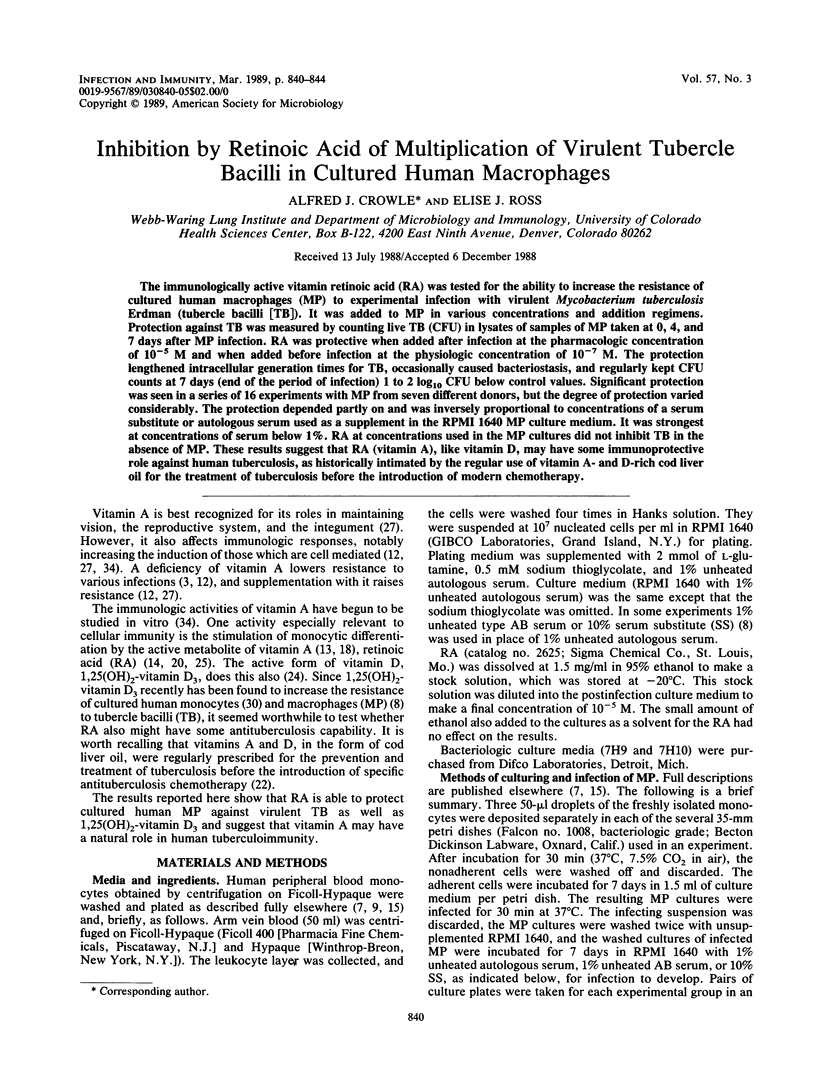
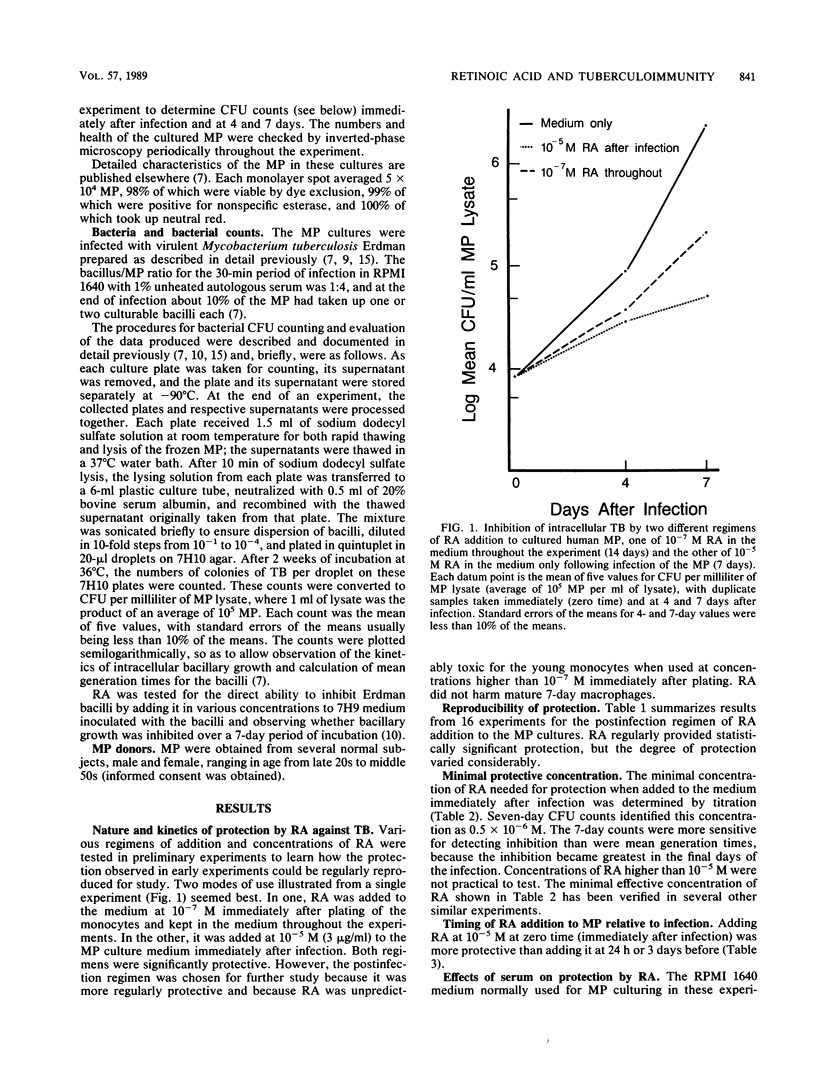
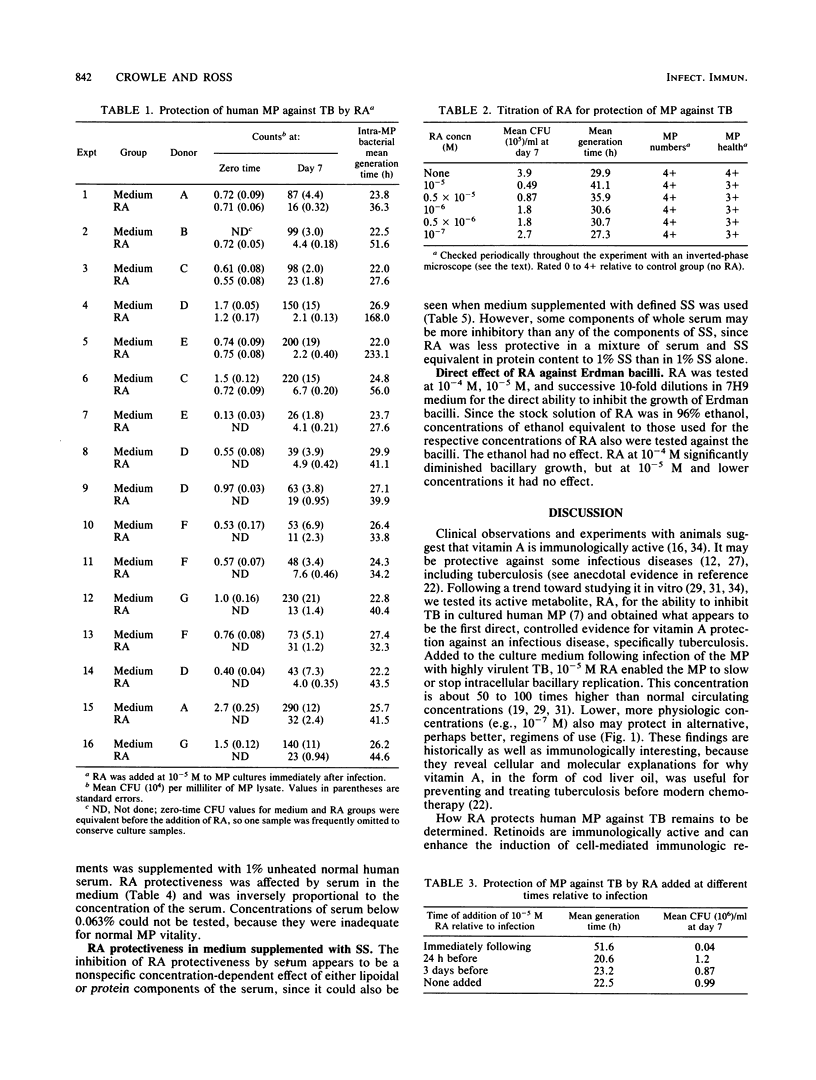
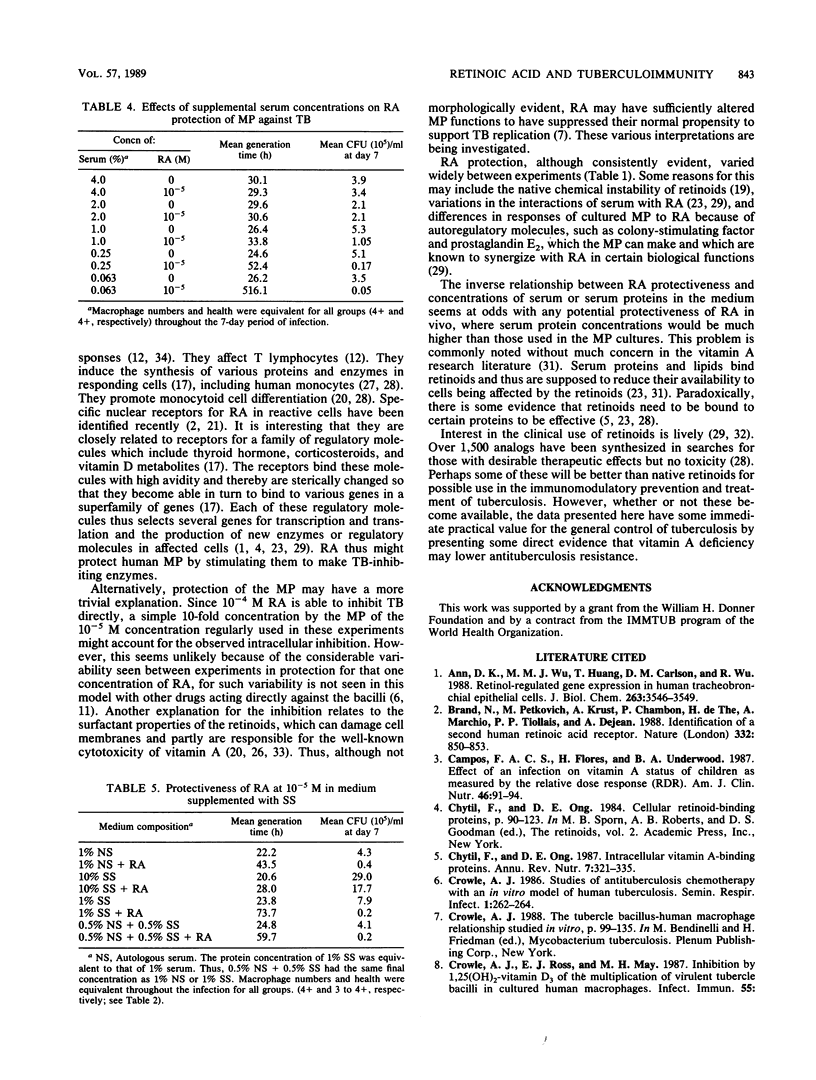
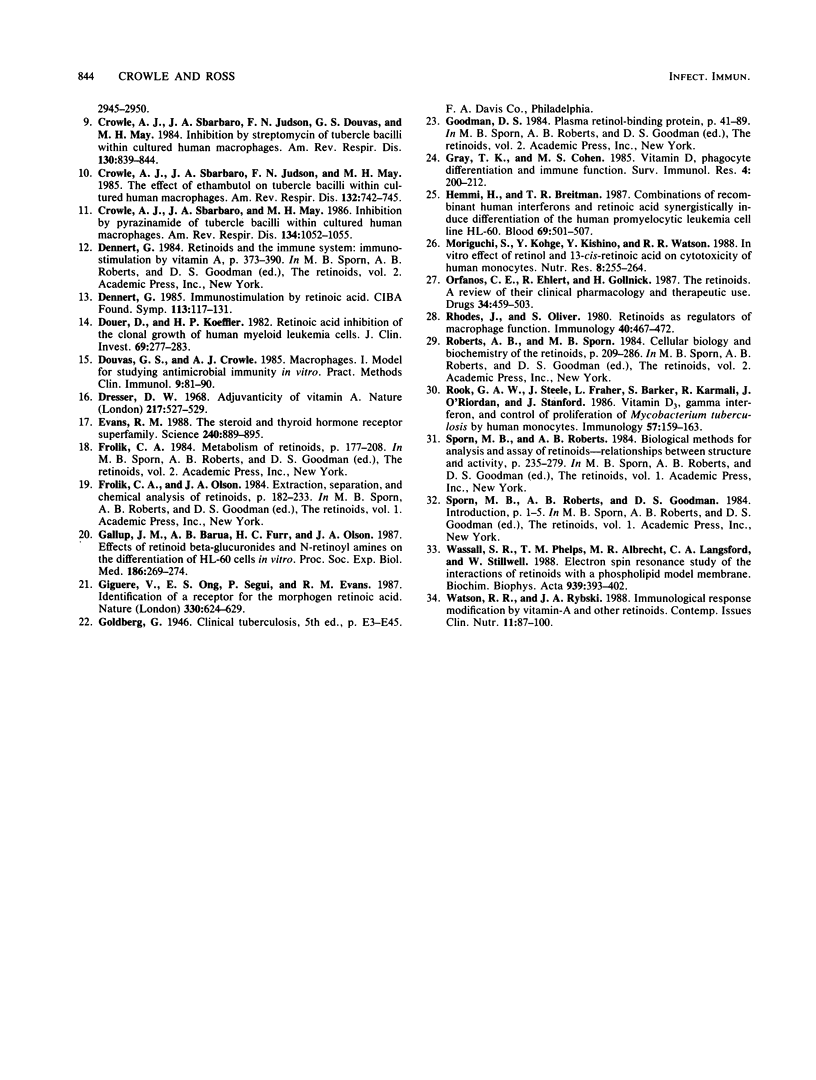
Selected References
These references are in PubMed. This may not be the complete list of references from this article.
- Ann D. K., Wu M. M., Huang T., Carlson D. M., Wu R. Retinol-regulated gene expression in human tracheobronchial epithelial cells. Enhanced expression of elongation factor EF-1 alpha. J Biol Chem. 1988 Mar 15;263(8):3546–3549. [PubMed] [Google Scholar]
- Brand N., Petkovich M., Krust A., Chambon P., de Thé H., Marchio A., Tiollais P., Dejean A. Identification of a second human retinoic acid receptor. Nature. 1988 Apr 28;332(6167):850–853. doi: 10.1038/332850a0. [DOI] [PubMed] [Google Scholar]
- Campos F. A., Flores H., Underwood B. A. Effect of an infection on vitamin A status of children as measured by the relative dose response (RDR). Am J Clin Nutr. 1987 Jul;46(1):91–94. doi: 10.1093/ajcn/46.1.91. [DOI] [PubMed] [Google Scholar]
- Chytil F., Ong D. E. Intracellular vitamin A--binding proteins. Annu Rev Nutr. 1987;7:321–335. doi: 10.1146/annurev.nu.07.070187.001541. [DOI] [PubMed] [Google Scholar]
- Crowle A. J., Sbarbaro J. A., Judson F. N., Douvas G. S., May M. H. Inhibition by streptomycin of tubercle bacilli within cultured human macrophages. Am Rev Respir Dis. 1984 Nov;130(5):839–844. doi: 10.1164/arrd.1984.130.5.839. [DOI] [PubMed] [Google Scholar]
- Crowle A. J., Sbarbaro J. A., Judson F. N., May M. H. The effect of ethambutol on tubercle bacilli within cultured human macrophages. Am Rev Respir Dis. 1985 Oct;132(4):742–745. doi: 10.1164/arrd.1985.132.4.742. [DOI] [PubMed] [Google Scholar]
- Crowle A. J., Sbarbaro J. A., May M. H. Inhibition by pyrazinamide of tubercle bacilli within cultured human macrophages. Am Rev Respir Dis. 1986 Nov;134(5):1052–1055. doi: 10.1164/arrd.1986.134.5.1052. [DOI] [PubMed] [Google Scholar]
- Crowle A. J. Studies of antituberculosis chemotherapy with an in vitro model of human tuberculosis. Semin Respir Infect. 1986 Dec;1(4):262–264. [PubMed] [Google Scholar]
- Dennert G. Immunostimulation by retinoic acid. Ciba Found Symp. 1985;113:117–131. doi: 10.1002/9780470720943.ch8. [DOI] [PubMed] [Google Scholar]
- Douer D., Koeffler H. P. Retinoic acid. Inhibition of the clonal growth of human myeloid leukemia cells. J Clin Invest. 1982 Feb;69(2):277–283. doi: 10.1172/JCI110450. [DOI] [PMC free article] [PubMed] [Google Scholar]
- Dresser D. W. Adjuvanticity of vitamin A. Nature. 1968 Feb 10;217(5128):527–529. doi: 10.1038/217527a0. [DOI] [PubMed] [Google Scholar]
- Evans R. M. The steroid and thyroid hormone receptor superfamily. Science. 1988 May 13;240(4854):889–895. doi: 10.1126/science.3283939. [DOI] [PMC free article] [PubMed] [Google Scholar]
- Gallup J. M., Barua A. B., Furr H. C., Olson J. A. Effects of retinoid beta-glucuronides and N-retinoyl amines on the differentiation of HL-60 cells in vitro. Proc Soc Exp Biol Med. 1987 Dec;186(3):269–274. doi: 10.3181/00379727-186-42612. [DOI] [PubMed] [Google Scholar]
- Giguere V., Ong E. S., Segui P., Evans R. M. Identification of a receptor for the morphogen retinoic acid. Nature. 1987 Dec 17;330(6149):624–629. doi: 10.1038/330624a0. [DOI] [PubMed] [Google Scholar]
- Gray T. K., Cohen M. S. Vitamin D, phagocyte differentiation and immune function. Surv Immunol Res. 1985;4(3):200–212. doi: 10.1007/BF02918673. [DOI] [PubMed] [Google Scholar]
- Hemmi H., Breitman T. R. Combinations of recombinant human interferons and retinoic acid synergistically induce differentiation of the human promyelocytic leukemia cell line HL-60. Blood. 1987 Feb;69(2):501–507. [PubMed] [Google Scholar]
- Orfanos C. E., Ehlert R., Gollnick H. The retinoids. A review of their clinical pharmacology and therapeutic use. Drugs. 1987 Oct;34(4):459–503. doi: 10.2165/00003495-198734040-00003. [DOI] [PubMed] [Google Scholar]
- Rhodes J., Oliver S. Retinoids as regulators of macrophage function. Immunology. 1980 Jul;40(3):467–472. [PMC free article] [PubMed] [Google Scholar]
- Rook G. A., Steele J., Fraher L., Barker S., Karmali R., O'Riordan J., Stanford J. Vitamin D3, gamma interferon, and control of proliferation of Mycobacterium tuberculosis by human monocytes. Immunology. 1986 Jan;57(1):159–163. [PMC free article] [PubMed] [Google Scholar]
- Wassall S. R., Phelps T. M., Albrecht M. R., Langsford C. A., Stillwell W. Electron spin resonance study of the interactions of retinoids with a phospholipid model membrane. Biochim Biophys Acta. 1988 Apr 7;939(2):393–402. doi: 10.1016/0005-2736(88)90085-5. [DOI] [PubMed] [Google Scholar]
- Watson J. T., Adkins-Regan E., Whiting P., Lindstrom J. M., Podleski T. R. Autoradiographic localization of nicotinic acetylcholine receptors in the brain of the zebra finch (Poephila guttata). J Comp Neurol. 1988 Aug 8;274(2):255–264. doi: 10.1002/cne.902740209. [DOI] [PubMed] [Google Scholar]


